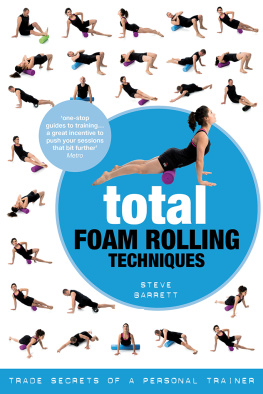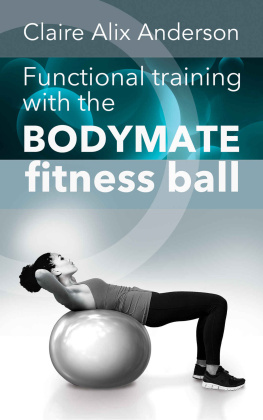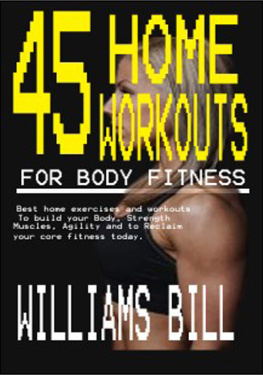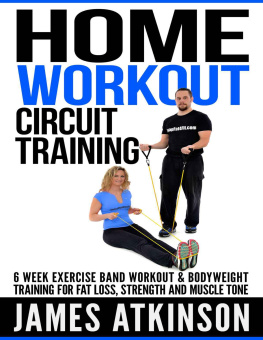Before attempting any form of exercise, especially that which involves lifting weights, always ensure you have a safe working environment. Ensure that the floor surface you are on is non-slip and do not stand on any rugs or mats that could move when you exercise. Also, clear your exercise space of items that could cause you harm if you collided with them; this includes furniture, pets and children. Pay particular attention to the amount of clearance you have above your head and remember that for some of the exercise moves you will be raising your hands and the weights above head height, so keep away from doorways and light fittings.
The information, workouts, health related information and activities described in this publication are practiced and developed by the author and should be used as an adjunct to your understanding of health and fitness and, in particular, strength training. While physical exercise is widely acknowledged as being beneficial to a participants health and well-being, the activities and methods outlined in this book may not be appropriate for everyone. It is fitness industry procedure to recommend all individuals, especially those suffering from disease or illness, to consult their doctor for advice on their suitability to follow specific types of activity. This advice also applies to any person who has experienced soft tissue or skeletal injuries in the past, those who have recently received any type of medical treatment or are taking medication and women who are, or think they may be, pregnant.
The author has personally researched and tried all of the exercises, methods and advice given in this book, on himself and with many training clients. However, this does not mean these activities are universally appropriate and neither he nor the publishers are, therefore, liable or responsible for any injury, distress or harm that you consider may have resulted from following the information contained in this publication.


contents
1
the basics of exercising with a gym ball

We need to exercise our bodies in a way that is achievable, effective and, most of all, sustainable so that the method becomes part of our lifestyle, rather than an inconvenience.
In a perfect world everyone would be able to lift their own body weight above their head, have ideal body fat levels and be able to run a four-minute mile. Any one of these goals is achievable if you are highly motivated and have very few other commitments in your life, but the reality is that most people are so far off this state of perfection that the biggest challenge is either starting an exercise programme, or staying committed and engaged with a method of training for long enough to see any kind of improvement.
Exercise is in many ways a perfect product, because it has very few negative side effects, it is cheap to do and highly versatile. But so many high profile, quick-fix programmes and products make exercise sound easy, as though it is a magic wand that once waved will bring near instant results. And with the fitness industry constantly driven by innovation in products and methods, the diverse and sometimes bewildering amount of advice available makes it all too easy to be overwhelmed. The truth is that many training programmes and methods will theoretically work, but the level of commitment needed is so high that when you add in work and family responsibilities, stress and other demands upon time, most of us simply cannot stick to a plan.
I also find that those programmes which seem too good to be true usually have a series of components that are not explicit in the headline, but are required to achieve the spectacular results it boasts about. So you sign up to a workout programme claiming: Instant fat loss ultra 60 second workout! only to find that to achieve the promised weight loss you have to go on an impossible 500 calorie a day diet. These methods also assume that everybody is fairly perfect already; by this I mean they dont have any injuries, they are strong, mobile and flexible and have a cardiovascular system that will soak up anaerobic training from day one. If these people are out there I dont see them walking up and down the average high street. There is a real need to approach fitness in a more down to earth, less sensationalist way. We need to exercise our bodies in a way that is achievable, effective and, most of all, sustainable so that the method becomes part of our lifestyle, rather than an inconvenience.

My S.A.F.E. trainer system (Simple, Achievable, Functional, Exercise) is all of these things. It is based on 20 years of personal training experience, including many thousands of hours of coaching, lifting, running, jumping and stretching with people from all walks of life, from the average man or woman to elite athletes. My system respects the natural way that the body adapts to activity and creates a perfect physiological learning curve.
All S.A.F.E. trainer system moves develop stability, strength or power. If youre not familiar with these essential components of human performance, I am sure that you will recognise the saying: You have to walk before you can run. This is the epitome of my approach, because when a client says they want to run or jump, the first thing I have to establish as a personal trainer is that they are at least already at the walking stage. I consider stability to be the walking phase of human movement, as it teaches you the correct muscle recruitment patterns; strength the running phase, as it trains the body to do these moves against a greater force (resistance); and power the jumping phase, since it teaches you to add speed and dynamics to the movement.
Like many of the most popular pieces of fitness equipment the gym ball was originally developed for use as a rehabilitation tool and then progressively became popular as a fitness product. Many of the exercises performed on the ball were originally conceived to strengthen individuals returning to exercise from an injury when the gym balls crossed over from being a rehab tool to becoming one of the most popular items of fitness equipment those exercises became increasingly incorporated into fitness programmes which is entirely logical when you consider that for many fitness professionals their first experience of using a gym ball was when they required treatment for an injury. This book focuses on all the positive reasons for using a ball and aims to help you enhance the results you get from the time you spend doing strength and conditioning training and will hopefully encourage you to think of a gym ball as something that is more than simply a comfortable place to do sit ups. When you get to the demonstrating the actual exercises (or moves as I like to call them) you will find that, rather than just being a list of exercises with a gym ball, I have focused on the moves that really work. There are hundreds of moves that can be done with a ball, but many of them are very similar to each other, ineffective or potentially dangerous. This book is all about combining skills and methods to create safe and effective fitness ideas to help you get the most out of your time with the ball.











